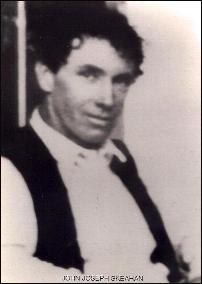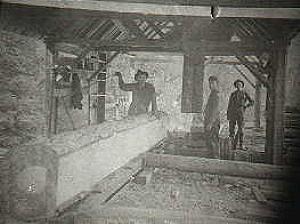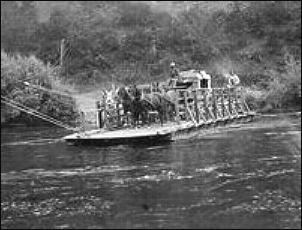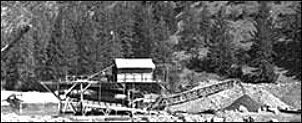
The following brief story is about Jack and David
Skeahan's grandfather, who was among those searching for gold
in the wilderness blend of narrow valleys, steep forested mountains
along the rugged Klamath River. John Skeahan (left) and Joe Davidson
were hardrock miners who dug tunnels deep into the mountain following
gold veins before and during early last century. When one tunnel was worked out, the
timbers were removed to build another leaving the original tunnel to
cave back in. Originally their claim was named Virginia Bar. Before Iron
Gate Dam was built 20 miles upriver, pelicans could be seen here diving
on salmon and steelhead. On Sundays, during the depression era, local
teenagers speared salmon selling them to onlookers for 25 cents to a
dollar.
To give you a better idea of essentials, and what it was like during the gold
rush, not far away was the town of Gottville. In 1851, William Gott
settled here to mine gold, and in 1857 built a home and post
office at the mouth of Lumgrey and Empire Creeks, establishing the town
of Gottville to serve the growing population of miners in the area. At
one time, some 3,000 people lived in this narrow canyon. A temporary
military encampment in 1860, by soldiers on their way to the Rogue
Valley Indian War, temporarily caused the attachment of the word "Fort."

William, James and John Wood started hydraulic
mining the area mid- 1855. They, like so many other practical miners
working near creeks, ran a water-powered sawmill (right) supplying
lumber for homes and flumes. Mail was sent across the river in a basket
via cable. Betty Freshour was the postmistress at Gottville from 1929 to
1942 after which the post office was moved downriver to the site of the
existing Klamath River Post Office. At that time, some wealthy property
owners of the area greatly influenced the name change from Gottville to
present day Klamath River.

Children attending school also rode across three
at a time when high water prevented them from using their boats. Hotels,
stores and saloons received supplies by pack train which had to cross
the river on one of the five ferries in the area (left). While fishing
for steelhead on the Klamath River in 1933, former President Herbert
Hoover visited the Honolulu School and learned of Elsie DeAvila's lunch
program, "the soup kettle." Hoover's first donation was $40. He
continued his yearly donation from then on and considered this school
his personal charity. This is believed to have inspired the country's
school lunch program. The school and a barn lay in the path of the new
road being developed in the late 30s. They were torn down and a third
Honolulu School was built below Lumgrey Creek which operated until the
late 1960s when it became a private residence.

The first traffic access to the north side of the
river was across the 1910 bridge, one mile east. The abutments remain,
though the bridge was wiped out by a doodlebug dredge (right) that broke
loose at Humbug Creek during a flood. One mile east of this site is the
Cayuse turnout where a public phone is located. Rock hounds can explore
the tailings, and nature lovers can observe wood ducks, kingfishers and
western pond turtles in the nearby pool.